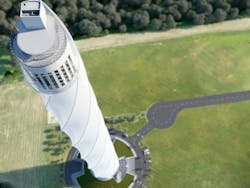Programmable Pendulum Finds Foreign Frequencies
Thyssenkrupp Elevator’s latest re-engineering feat deploys an existing technology in a way that refines the tall building experience. Tall and super-talls rely on advanced modeling and structural engineering calculations, but their ability to remain standing also involves mass pendulums. A more covert aspect of tall building construction, megaton pendulums help absorb vortex-induced vibrations and sway due to wind, weather or seismic shifts. Mass pendulums’ stabilizing forces mitigate building occupants’ perceptions of these motions and reduce fatigue loads.
ThyssenKrupp’s 246-m tower, nearing completion in Rottweil, Germany, now boasts a 240-ton mass damper recently hoisted into place at the 193-m mark. After analyzing and recording the building’s natural sway and motion, the research and development facility’s pendulum is calibrated and tuned to allow precision control of the building, reducing sway of the tower from a maximum of 76 cm in one direction, to less than 15 cm.
The passive pendulum includes an intelligent interface developed by Thyssenkrupp Elevator and GERB Schwingungsisolierungen; the system monitors the building motion and the damper motion as it stabilizes the building. This sophisticated program was conceived to initiate controlled artificial motions that replicate real weather and sway conditions present in certain tall and super-tall buildings. It is the first pendulum interface in the world to combine passive and active motions, allowing precision development of custom-calibrated elevators designed to suit an existing building or a building in development.
Currently, the majority of elevator research and development happens in static test shafts that descend deep into the ground. The impressive tk-GERB-developed pendulum system will be significantly more accurate than test shafts and tops today’s engineering modeling software, which may fall short in predicting complex relationships between elevator cab, shaft and building.
To create this artificial simulation technology, movement is instigated by controlled deflection of the pendulum by electromagnetic linear motors, causing it to oscillate. The moving mass of the pendulum then pulls on the tower, setting it in controlled motion. Electromagnetic linear motors are integral to Thyssen- Krupp’s MULTI vertical transport system, which will be tested in three of the twelve elevator shafts in the test tower, which is set to be fully operational this fall.
